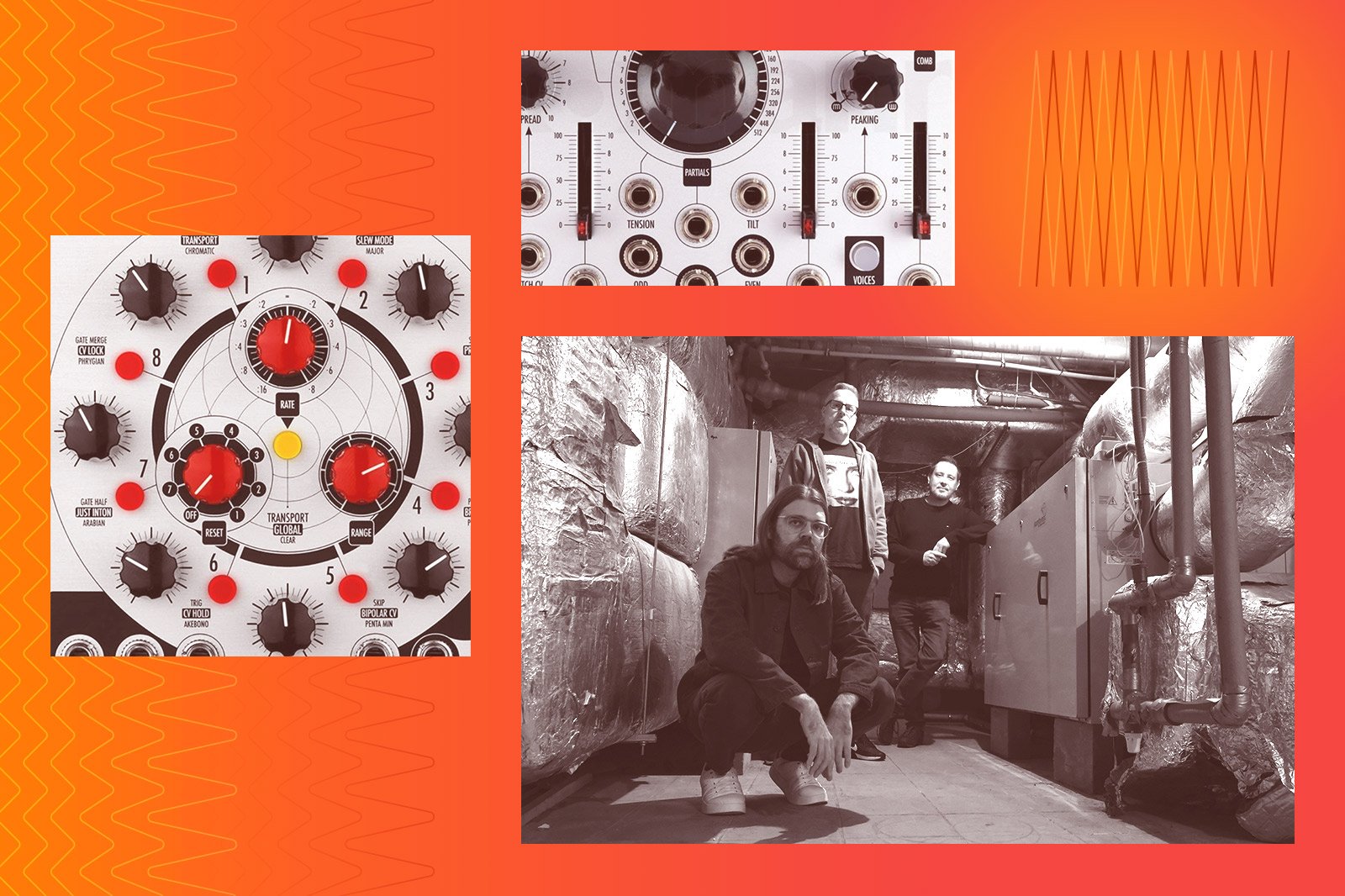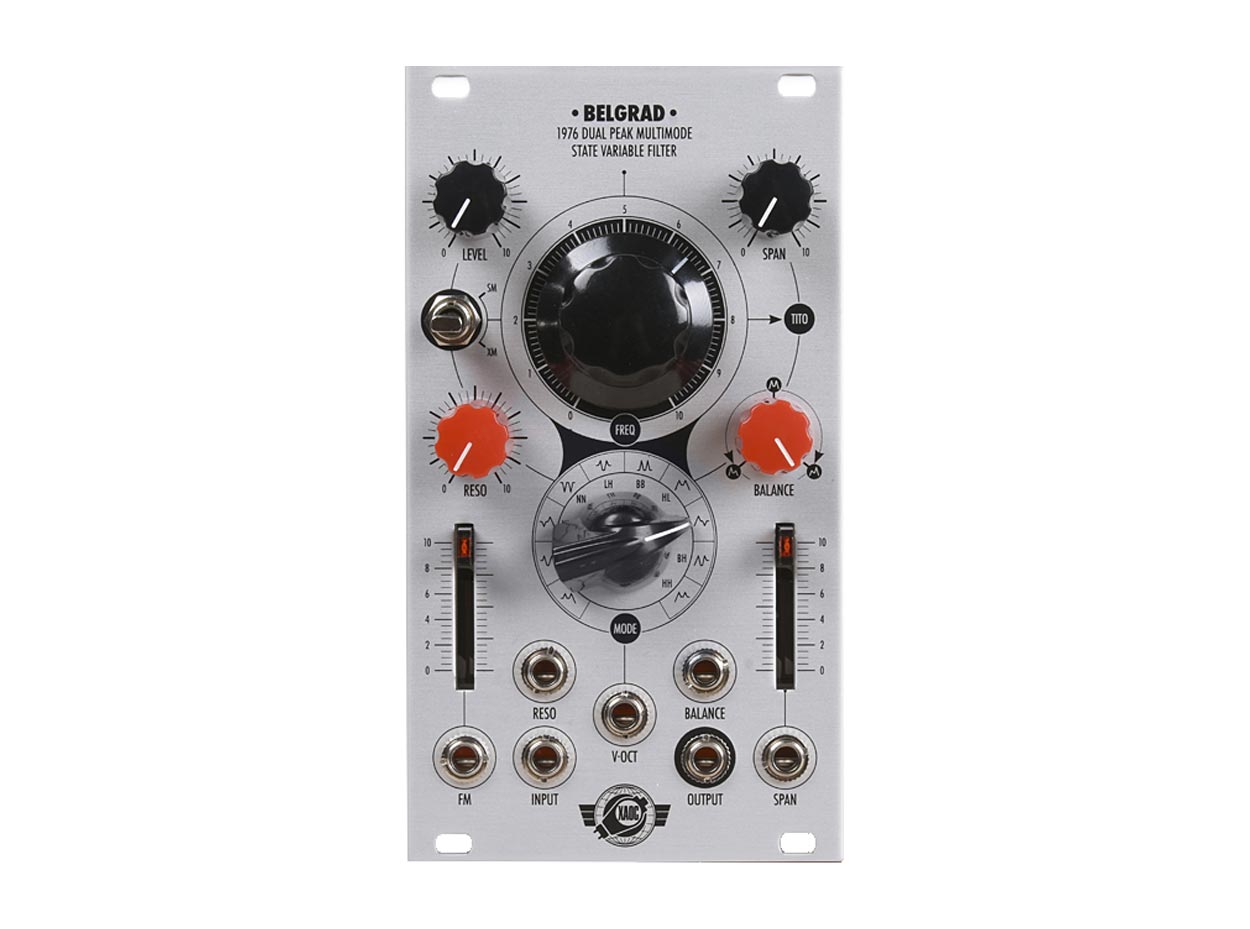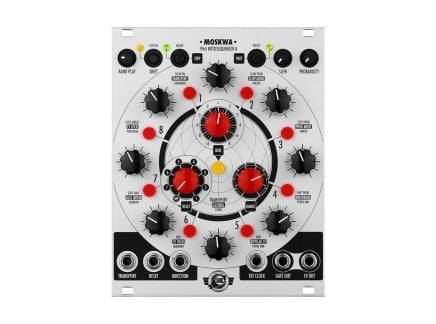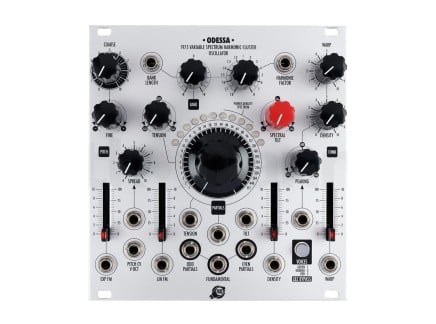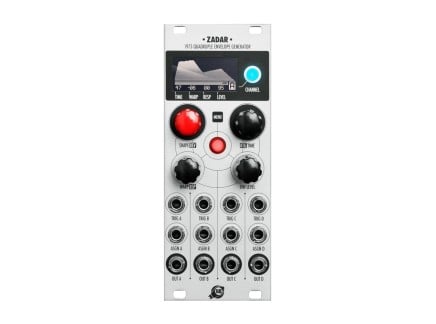The principle of form follows function worked from the assumption that something came into existence due to function, purpose, or need. A guiding tenet, one that shaped everything from architecture to automobiles to musical instruments, with far reaching and enduring impacts on things like usability, aesthetics, and overall design philosophies, the prevailing ideas favored the rational over aesthetic-based stylistic concerns. But form and function are amorphous concepts that can and have changed with perspective and time. Moreover, the distinctions between pure functionality and aesthetics are hard to uphold: beauty can indeed be found in the functional; the functional has its own rhythm and design that can be pleasing.
In the case of early Eurorack modules, silver faceplates with black text were the de rigueur of the early years, and spoke to what was important at the time: the feature set, the functionality. Polish company Xaoc Devices (pronounced "chaos") was born in 2011 from the imagination of graphic designers, Tomek Mirt and Marcin Łojek. Their backgrounds allowed them to utilize a different sense for balance, patterned design elements, and refined use of color, but they were also determined to make sure that the functionality met their standards, that form and function went hand in hand, that both elements upheld their end. Tomek and Marcin—along with their engineer Maciek Bartkowiak— operate from an artist/engineer perspective, converging theory and sensibility into practice. Xaoc Devices has become one of the cornerstones of the Eurorack community. Modules such as Moskwa, Zadar, Batumi, Odessa, and Belgrad (among others) have become classics, and each new Xaoc Devices release finds an audience eagerly anticipating its arrival. With their strong aesthetic and interfaces that elevate the user experience it’s sometimes a marvel to realize that something as simple as a single red knob among a well-designed and laid-out faceplate can make a module stand out in a rig, and therefore make it more prone to being played and more apt to providing creative output; a true testament to their vision and partnership.
Interview with Tomek Mirt + Marcin Łojek
Waveform: How did you two meet?
Tomek Mirt:We met many years ago within the electronic underground industrial ambient scene and then we reunited about twelve years ago on Muff Wiggler [Ed. - now Mod Wiggler] because we discovered that we were both modular fanatics.

Waveform: What was the modular scene like in Poland back then?
TM: It was really tiny, almost nonexistent.
Marcin Łojek: Like four people or something. [Laughs] So we met again and it just clicked. We had ideas we wanted to do something with and I wanted to quit my day job finally.
Waveform: So you started Xaoc. What was it like in the beginning?
TM: We had no idea what we were in for as our first years were quite far from stability. When we started the company, we were just two graphic designers; we could just do panels and logos and stuff like that. There was a huge amount of things that we needed to learn. We had some experience with DIY, but it wasn’t enough, we needed an engineer.
ML: The first year was just trying to design the first product.
TM: We were bringing some ideas and it was just growing. It was Moskwa, Bytom, and Warna at the same time.
ML: We had a lot of ideas for the functionalities and features, but we were working from home, and our first engineer was living in another city most of the time...it was a mess. I'm not sure now how we even managed to assemble and test the first batch of modules, but it was fun. When we finally had an office we started to feel we were more like a serious company. We were extremely excited by everything that was happening, and constantly discussing new ideas, but it was difficult for us to make these ideas a reality; it was hard to finalize any project. We were working on Praga, and it was a big step forward for us, but the development was progressing at a very slow pace. Praga had become vaporware due to the time it took us to deliver it to the market after the official announcement. It took so long, because we didn’t want to compromise on anything, but we knew that the delay would affect our image. One of our friends recommended Maciek, who is a synth aficionado, a modular addict, and was a postdoc at the Poznań University of Technology. He had a really big knowledge about DSP and circuitry.
TM: In the end it paid off because we were super strict about the quality of the design and the circuit, and people started to notice that. The modules are really sophisticated—sometimes it's even more sophisticated than it should be—and we are not taking any shortcuts with our designs. It's tricky, but I think we found a balance.
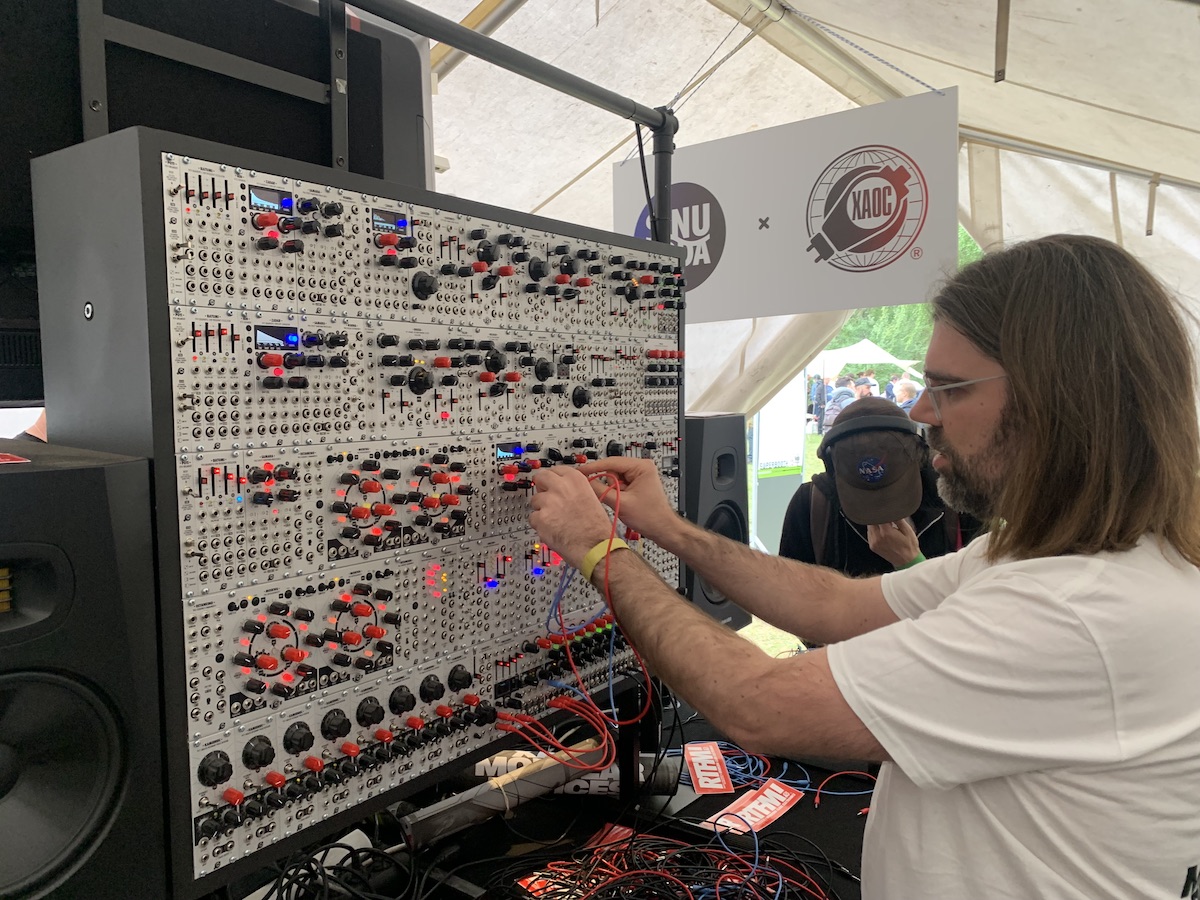
Waveform: Were you both scared to leave your previous jobs in order to do this?
TM: I wasn't scared, but I never had any office job, I was always freelancing.
ML: I was so frustrated that I just wanted some excuse to leave. I loved graphic design, but the whole brand, the whole industry...I was really an anticapitalist kind of person and I was putting a lot of my work and effort to make people buy shit they didn't like and didn’t need. When we started Xaoc, it was the opposite. I loved that we were getting a lot of feedback, that people loved our stuff, and they were happy. For the first time in my life, I felt that I made something that made people happy. It was a big, big change.
Waveform: It looks like you've succeeded.
ML: Hopefully! [Laughs] I think more or less it was the same for the other companies, from enthusiasm in the hobby to something much more serious. Also, our families, even our parents are proud of what we have achieved. So for all of us, it was actually a life changer and the quality of our lives is much different. It gives us a lot of freedom, the freedom to create without any limitations and stress.
TM: We know that we are really lucky. With this company, it is easy to be enthusiastic.
Waveform: It's interesting that you started the company with ideas about the way the modules should look and with ideas of function, but that you had no way to carry out those ideas for the functions, the actual workings of the modules, and had to find somebody to carry all that out.
ML: It's because we are gearheads, fetishizing the gear we wanted and what would appeal to us.
TM: We are also coming from music underground, so it was natural for us. Like how you start playing music and you start some label to release your music. It was really natural for us to start the company. It's not like we didn't have any idea. I'm an industrial designer. We could design the product, but not the electronic circuit. We knew what was realistic and feasible.
Waveform: The fact that you were both graphic designers explains why Xaoc has had such a strong visual aesthetic from the outset. Was the design element something you bonded over in the beginning?
TM: It was important in the beginning because most of the modular manufacturers were engineers. I think there was a small shift to designing a whole product, and I feel that we helped move it a bit.
ML: My impression is that our approach to aesthetics maybe inspired other manufacturers to pay more attention to this. After we introduced our products more manufacturers were caring about the front panel designs and the ergonomics.
Waveform: We talk about how product design and aesthetics matter even more now. In the beginning, it was all about "What does it do?" and there's Sharpied-on text on the faceplate...it didn't really matter.
TM: Yes, it was smaller, more experimental. Now, it is really big so you need to show people something really interesting, something that will instantly grab them because there are hundreds of modules. No one is really waiting for another one like ten years ago. Before, you'd show something really simple and everyone on Mod Wiggler was like, "I need this." Now we are showing a module that is really complex, DSP-based. The saturation is big now, the community is huge.
Waveform: Who is on the design team for Xaoc modules now?
TM: The main core now is us and Maciek. During the design process, we are talking a lot.
ML: It's always a brainstorm.
TM: That is always the process and we are changing a lot during this. It's not like one of us is starting with a really finalized design and then we start the construction.

Waveform: So after all these years, how do you find working together?
ML: I still have a lot of enthusiasm, even if not as much at the start. [In the beginning], we were on the phone for like two hours each day, talking and talking about modules, and pretty much nothing happened for a year. Finally it happened and it was a big success for us.
Waveform: You must have been relieved!
TM: Yeah, it was a big relief, really, because we know that this is the way for us. The adventure, the fun is there, and you can't go back and do what someone is telling you, and there was really tons of enthusiasm for it in the whole community.
ML: The early Mod Wiggler community was kind of like a hardcore punk community; really ethical, caring about each other. Friendship and cooperation. To some extent it still is. Among those older manufacturers that we know and are friends with there's still a lot of cooperation, helping each other.
TM: There was a lot of knowledge on the forum, it was really something totally unique.
Waveform: How have you noticed that the industry has changed since you entered it?
ML: The demographics of modular users has changed a lot. Back then it was a cottage industry and everyone was contributing, even the users. I remember showing the preliminary designs on Mod Wiggler and people had some advice or questions. It was really a creative process that included the users. It's not like that anymore, because everyone is low profile. I think we helped some other manufacturers a lot, sharing our knowledge of manufacturing processes and our subcontractors and this and that. Just as other folks from the industry helped us somewhere in our journey—it was exactly as a family. For example, I remember the day that we had so much trouble delivering the Praga mixer because it was a much harder project than we expected. We had a lot of troubles and Scott [Jaeger] from Harvestman [now Industrial Music Electronics] asked, "Are you releasing Praga this summer, because I have a mixer and I can wait until you release your mixer?" Isn’t that just sweet? I'm a total fan and I actually own pretty much everything he's done.
TM: He made the really big change, he brought digital technology to the modular scene.
ML: At the time everyone was like "Analog only, no digital." He was so bold. It was a really strong personality behind those modules.
TM: I think it was eye opening like, you can use all types of technology. It's not only analog and digital because you have this digital high-tech DSP stuff, and you have also this 8-bit digital, you have tubes in the analog realm and a thousand things in between. I think this a big strength of Eurorack, that you can find some really crazy ideas and they work well together with something totally different, you can mix everything as you like. We are really doing one product, it’s just a synthesizer that someone will have as just one piece of gear, but there will be lots of different manufacturers that made this one synthesizer.
ML: The variety of Eurorack is its beauty. It's not consistent, and it's not homogenic, but that's the point. Your system is growing to your needs, and to your ideas.
Waveform: Moskwa was one of your first modules and now you’ve got the Moskwa II. Why did you do a new version of that module?
ML: The Moskwa II is a kind of staple for the whole decade of our company. That's why we wanted to keep exactly the same form factor [as Moskwa I] but to contain much more features.
TM: For us, it is a bit iconic. It was quite a good product, but for today’s standard it is not enough. Moskwa was a feature-packed module ten years ago, and now it's almost a toy compared to modern sequencers. [Laughs] Moskwa II is doing really lots of crazy stuff that probably ten years ago would blow your mind.
Waveform: How has your involvement changed the scene in Poland? Has the scene there grown at all?
ML: When we started we were so enthusiastic about the modules and Eurorack that we started a blog, a series of synth meetings, and concerts just to attract more people. There were a lot of people visiting us, and we didn't know them, but they were bringing their systems and other music equipment to our synth meets. It was growing so fast that we decided to step back because we didn't have much time anymore running the company. Now it's a lot of people.
Waveform: How is it overall, having a Eurorack company that’s based in Poland?
ML: There are advantages and, of course, shortcomings. The advantage is that a lot of things are much cheaper, so that helped us a lot. On the other hand, we are so far from the scene, from the community, that sometimes it is really hard for us to go to the events, to fly around the world to meet people. It is an effort. Still, we didn't feel like it was a big problem. Berlin is nearby and some dealers were interested in our first designs and really helped us initially, like Shawn [Cleary] from Analogue Haven, Schneidersladen and Escape From Noise. I think we were the first Eurorack company coming from Eastern Europe. Of course, now there's a lot of them, but back then I think it was only us.
Waveform: Now that you’ve been around a while where do you draw your inspiration for new modules, new ideas, and new functionalities?
TM: There's really lots of different places where we find inspiration, especially when the ideas come from three different people. Sometimes it's something simple. For example, Maciek knows really well how analog to digital conversion works in hardware, but when I realized that you can change the control voltage into eight gate signals, it started this whole Leibniz [Binary] Subsystem, so there was this little spark that came from nowhere. Then we started talking about the possibilities and Maciek was bringing lots of ideas how you can process in the digital domain. We were asking, "Is it possible to make another module from this idea?" Sometimes one of us has a general initial idea and the other one just adds to this and it starts some sequence, and another person is ending this. I think most of the inspiration is just from us talking together and exchanging some concepts, experiences, observations. It's also other products that influence us. You buy a module and you think it is really great and it would work well with something that is missing in the system, and you can make another module and it will be another brick to the bigger whole.
ML: We are really fanatic about modular and aware of pretty much every module on the market and every function. We have the big picture, what's in the market, and what is lacking in the market so we try to find some niche, some new idea, something against the grain. In our brainstorm sessions, one of us says, "Nobody would be using this because nobody needs that." The other one will be like,"I need that!" In the end, it is always, more or less, a success. I think the creative process is really good in our company.
TM: Sometimes even just playing a live show, it’s like, "Oh, I should have some small thing." It is nice when you can just design it, but we need to be more responsible now.
Waveform: What do you mean?
TM: For quite a long time all the risk was just on Marcin and me. If we made a stupid decision, we were the only ones to pay for such a mistake. Now, we employ people that put trust in our decisions. If a particular module doesn’t sell well, we might not be able to recoup our costs. It is quite stressful. It definitely affects us, but can also be a problem for the whole team. After ten years our way of working has slowly become a daily routine. Not every day is an exciting adventure in the world of modular synth wonders, but on the other hand so many things are easier now.
Waveform: Did you ever imagine that you would be at this point when you first met and were talking about modules together?
TM: It was really hard to imagine this.
ML: No, I'm a pessimist! When we started, we just made fifty units and that was a big number for us. It was normal in Eurorack at the time because most of the modules were made by someone just sitting around at home and soldering the modules on demand. We had shown the design on Mod Wiggler and elsewhere and we got an email from Analogue Haven saying, "I want to buy 300 of those." We were like, "That's crazy, but let's do it!"
Waveform: I'm curious about the creative partnership between the two of you, if either of you had any kind of relationship like this before where you relied on another person to create in either the graphic design or maybe some kind of previous work?
ML: Probably, no. We have some meeting points in our lives, but we came from different backgrounds. Of course, we still argue a lot, but it's creative and brings something to each other. I think it's kind of a unity of opposites sometimes.
TM: As long as we can talk about everything together, it is great, and will only grow. There are some people that I have known for a long time, but this is really something different.
ML: We are maybe not talking to each other as much as we used to, but we still know each other well.
Waveform: No more late-night two-hour phone calls?
TM: We just don't need to talk about this as much anymore because we have the same life almost. We spend most of the day together in our office.
ML: We needed to learn how to deal with each other because pretty much every person in the core of our company is totally different.
TM: We're so different. We know each other and can think a different way.
Waveform: Would you say there's order in the chaos? [laughs]
TM: No, it's just pure chaos!
ML: We still operate as it was from the start, and we want to grow a bit to step out of Eurorack with pedals, desktops, and [other] synthesizers. We don't want to kill the joy of running the company. Of course it's a hectic, chaotic, and sometimes a really stressful thing, but still we have fun doing this.
Waveform: How does working on modules every day affect your artistic output?
ML: Tomek is releasing a lot of records; I'm kind of jealous. I don't have much stamina to do it anymore and I'm not so prolific, but sometimes I want to start a band again.
TM: I need to do music and I have to record an album every now and then. It’s like a clock for me, a kind of a mechanism that divides my life into stages. Making modules affects my music, especially as I like to use our modules, and I wouldn't have such a huge system without Xaoc! Maybe it wouldn’t be so modular oriented either.
ML: For me, it's like a kind of meditation. I don't actually have any need to release anything, as there's a ton of crap out already. For the first time in my life I actually own a decent home studio and a lot of equipment. I liked to sit around just noodling, but now it rather bores me to death. To clear my mind I ride my MTB to the forest.
TM: This is a good attitude, to not have this need to show someone.
ML: Well, I'm a bit of a coward and I think the opinion of others—or the lack of opinion—will somehow be hard to experience, but to be honest, I don't care anymore. I release music for my friends, paying for the vinyl pressing and this and that. I would love to release my own music, but it means that I will need to finish something.
TM: You are a bit of a control freak.
ML: Yes. That's the problem.
Waveform: Would you say that even in terms of the business, the interaction between you two is somehow balanced? One is a self-characterized pessimist and a perfectionist, but it's countered with....
TM: I'm also a pessimist [laughs], but I call myself a realist! It's like with the graphic design for our stuff, we started doing this together and Marcin is doing this really great, so usually it is just better when I am not distracting him and I can focus on other parts of the designing process.
ML: It's the process. Sometimes I'm stuck and Tomek has ideas. It's really good because I might be designing a panel for a month or something; it needs to be perfect! On the serious side, however, it pays off big time.
TM: A lot of time, I just have the idea that it's the time to finish the designing; it's enough, it's done. The graphics can get lost sometimes in a bunch of cables and things, but there is also the placement of the knobs, the size of it, which parameters you will do on the slider, which one on this big knob, the smaller knob. These are puzzles that you can improve on endlessly.
ML: Sometimes it's extremely hard to design it to be aesthetic and preserve the performability.
TM: This is really the problem of industrial design: that you have this PCB and there are some elements, some knobs that need to be close to some chip, for example, and you should leave this in some totally strange place, and it really doesn't fit any aesthetic project.
Waveform: A lot of your designs seem to be very symmetrically minded.
ML: Actually, I hate that.
Waveform: Really? You hate it? I find peace in symmetry.
ML: Our engineer makes fun of me because I’m making everything symmetrical, but for some reason in most cases, it's the only way that works. On our Belgrad filter there is a thing that looks like a bowtie or something and I noticed that two months after releasing the module.
Waveform: I always thought Belgrad was so cool looking. In terms of names, you usually have a year like 1976 or 1969 and some city name. What's the idea behind that?
ML: Our “ideology” from the aesthetic side of things is that we are hinting to the communist era of consumer electronics—what we remember from our childhood— but with a kind of retro look. We use only dates and names of cities from the times of the communist rule from the Eastern Bloc.
TM: In communist Poland, the radios and TVs were sometimes named after rivers, cities, and so it seemed a really good idea to name modules in the same manner.
Waveform: You talked about stepping out of Eurorack a bit. Do you have plans to release anything different sometime soon?
ML: We have tons of ideas of different kinds, from really basic small instruments to advanced bigger ones, and also for pedals. Not necessary guitar pedals, but more targeted at the experimental crowd. I'm a guitarist, but I don't use pedals, but for electronic music, I love some crazy pedals. We want to develop some more things like that and we even thought about some acoustic things, new approaches to really old studio equipment like plate reverbs.
TM: We have some ideas that are really hard to put into a module. We're thinking of really different things and not just strictly electronic. It's fun to design something different.
Thanks to Waveform Magazine
Waveform is a quarterly print magazine about sound synthesis and those who inhabit that world. Check out Waveform on our site, or head to their own website to subscribe, grab some swag, DIY projects, and more!
Image credits: Tomek and Marcin, Superbooth 2021; photo by Sam Chittenden. Tomek at Superbooth 2022; photo by Sam Chittenden. Tomek, Marcin, Maciek, 2023; photo provided by Xaoc Devices.

